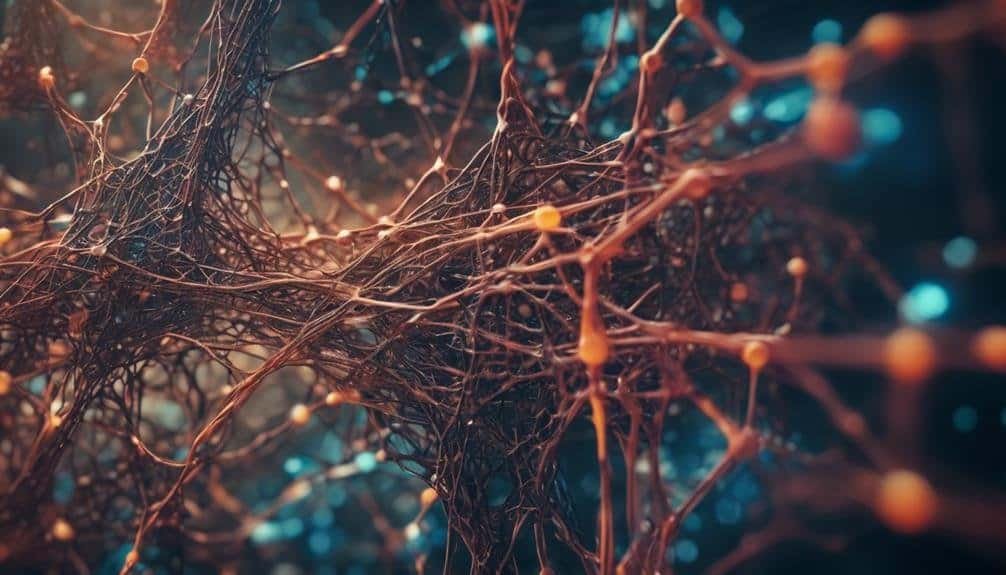Deep Learning Demystified: An Introductory Guide
Deep learning has become a buzzword in the realm of artificial intelligence, but what exactly is it and how does it work?
By demystifying this complex topic, we aim to shed light on the fundamental concepts that underpin deep learning.
Understanding the history, applications, and differences between deep learning and machine learning is crucial in grasping the potential of this powerful technology.
So, let's take a step into the world of deep learning and unravel its mysteries together.
Key Takeaways
- Deep learning involves interconnected neural networks inspired by the human brain.
- Training deep learning algorithms improves performance over time.
- Applications span various industries like healthcare, finance, marketing, and automotive.
- Understanding neural networks, backpropagation, and activation functions is essential for deep learning.
What Is Deep Learning?
Deep learning is a subset of artificial intelligence that involves the use of neural networks to mimic the way the human brain learns and processes information. These neural networks consist of interconnected nodes that work together to process complex data inputs and deliver outputs accordingly. Deep learning algorithms, a key component of this technology, enable machines to learn from large amounts of labeled data and make decisions or predictions based on that information.
Neural networks are structured in layers, with each layer processing specific aspects of the data before passing it on to the next layer. This layered approach allows for the extraction of intricate patterns and features from the input data, leading to more accurate results. Deep learning algorithms, through the use of neural networks, can autonomously adapt and improve their performance over time as they are exposed to more data, a concept known as 'learning'.
In essence, deep learning leverages neural networks and sophisticated algorithms to enable machines to learn from data, recognize patterns, and make decisions without human intervention.
History of Deep Learning
With the advancements in computational capabilities and the growing interest in artificial intelligence, the history of deep learning traces back to the early development of neural networks. Here is a brief overview of key milestones in the history of deep learning:
- 1943 – McCulloch and Pitts Model: The first mathematical model of a neural network was proposed, laying the foundation for future developments in artificial neural networks.
- 1950s – Perceptrons: Frank Rosenblatt developed the perceptron, a type of artificial neuron that could learn and make decisions, advancing the field of neural network research.
- 1980s – Backpropagation: The backpropagation algorithm, a method for training multi-layer neural networks, was introduced, enabling more complex neural networks to be effectively trained.
- 1990s – Evolutionary Algorithms: Researchers started combining neural networks with evolutionary algorithms to improve learning and optimization processes, leading to advancements in deep learning techniques.
These milestones reflect the evolutionary journey of deep learning, from the basic principles of neural networks to the integration of advanced algorithms for enhanced learning capabilities.
Key Concepts in Deep Learning
Foundational to understanding deep learning is grasping the fundamental architecture of neural networks. Neural networks are a key concept in deep learning, designed to mimic the way the human brain operates. These networks consist of layers of interconnected nodes that process data inputs to generate outputs. The Backpropagation algorithm is another crucial concept in deep learning. It is a method used to train neural networks by adjusting the weights of connections to minimize the difference between the actual output and the desired output. This iterative process helps neural networks learn and improve their performance over time.
To illustrate the concept visually, consider the following table:
| Neural Networks | Backpropagation Algorithm |
|---|---|
| Mimic human brain | Adjusts weights |
| Layers of nodes | Minimize output difference |
| Data processing | Training method |
Understanding neural networks and the Backpropagation algorithm is essential for delving deeper into the applications of deep learning, which will be discussed in the next subtopic.
Applications of Deep Learning
The applications of deep learning encompass a wide array of real-world uses, showcasing the versatility and power of this technology.
From image recognition technology that enables machines to identify objects in images with remarkable accuracy to natural language processing systems that facilitate human-machine communication, the impact of deep learning is profound and far-reaching.
These applications highlight the innovative ways in which deep learning is revolutionizing industries and driving advancements in artificial intelligence.
Real-World Applications
Harnessing the power of deep learning algorithms has revolutionized industries across the globe, with real-world applications ranging from healthcare to finance. Some notable examples of deep learning applications include:
- Healthcare: Deep learning is used in medical image analysis, disease diagnosis, and personalized treatment recommendations.
- Finance: In finance, deep learning models are employed for fraud detection, algorithmic trading, and risk management.
- Marketing: Deep learning enhances targeted advertising, customer segmentation, and sentiment analysis to improve marketing strategies.
- Automotive: The automotive industry utilizes deep learning for autonomous vehicles, driver assistance systems, and predictive maintenance, enhancing safety and efficiency.
These applications showcase the significant industry impact of deep learning technologies.
Image Recognition Technology
Deep learning's impact on various industries, such as healthcare, finance, marketing, and automotive, underscores its transformative potential, particularly in the realm of image recognition technology. In image recognition, deep learning models can classify and detect objects within images with remarkable accuracy. Two key techniques that enhance image recognition systems are data augmentation and transfer learning. Data augmentation involves artificially expanding the training dataset by applying transformations like rotation or flipping to existing images, thereby improving model generalization. Transfer learning utilizes pre-trained models on vast datasets, adapting them to new tasks with smaller datasets, enabling faster and more efficient training. Below is a table illustrating the applications of image recognition technology:
| Application | Description | Benefits |
|---|---|---|
| Healthcare | Diagnosing diseases from medical images | Improved accuracy |
| Automotive | Autonomous driving systems | Enhanced safety |
| Marketing | Targeted advertising | Personalized campaigns |
| Security | Facial recognition for access control | Heightened security |
Natural Language Processing
Advancing natural language understanding through deep learning techniques has revolutionized various industries, showcasing its potential in transforming how machines interpret and interact with human language. Deep learning in natural language processing enables applications such as sentiment analysis and text generation.
Applications of Deep Learning in Natural Language Processing:
- Sentiment Analysis: Deep learning algorithms can analyze and categorize opinions expressed in text, providing valuable insights for businesses to understand customer sentiment.
- Text Generation: Deep learning models like GPT-3 can generate human-like text, revolutionizing content creation and natural language generation tasks.
- Language Translation: Deep learning has improved machine translation systems, enabling more accurate and fluent translations between languages.
- Speech Recognition: Deep learning techniques enhance speech recognition systems, enabling accurate transcription of spoken language into text.
Deep Learning Vs. Machine Learning
When comparing Deep Learning to Machine Learning, the key points of differentiation lie in the level of complexity and the underlying learning models used.
Deep Learning, with its multiple layers of neural networks, tends to handle more intricate tasks and larger datasets compared to Machine Learning.
Machine Learning, on the other hand, typically involves simpler algorithms and is more suitable for tasks with well-defined features and smaller datasets.
Deep Vs. Machine
A clear distinction between deep learning and machine learning lies in their underlying architectures and methodologies. When comparing the two, it's essential to understand the following:
- Depth of Neural Networks:
- Deep learning utilizes deep neural networks with multiple hidden layers, enabling it to automatically learn features from data.
- Feature Engineering:
- Machine learning often requires manual feature engineering, where domain knowledge is used to select relevant features, while deep learning automates this process.
- Data Representation:
- Deep learning algorithms work directly with raw data, requiring large datasets for training, whereas machine learning models often rely on preprocessed data.
- Performance with Big Data:
- Deep learning excels in handling big data due to its capacity to process vast amounts of information, making it a powerful tool in artificial intelligence tasks.
Complexity Contrast
The complexity contrast between deep learning and machine learning lies in the intricate nature of the underlying algorithms and the level of abstraction they operate at. Deep learning involves neural networks with multiple layers, enabling it to automatically extract features from data, leading to higher accuracy but at the cost of increased computational complexity. On the other hand, traditional machine learning algorithms deal with less complex models and are more interpretable, making them suitable for smaller datasets and cases where explainability is crucial. The training contrast is notable, with deep learning requiring large amounts of labeled data for training, while machine learning models can often perform well with less data.
| Aspect | Deep Learning | Machine Learning |
|---|---|---|
| Computational Complexity | High due to multiple layers and parameters | Lower compared to deep learning |
| Training Contrast | Requires large labeled datasets | Can perform well with less data |
Learning Model Differences
In comparing the learning models of deep learning and machine learning, the fundamental distinctions lie in their approach to feature extraction and model complexity.
- Neural Network Architectures: Deep learning primarily employs complex neural network architectures with multiple hidden layers, allowing for intricate feature extraction.
- Training Algorithms: Deep learning often uses backpropagation and gradient descent for training, enabling the network to learn intricate patterns in data.
- Supervised vs. Unsupervised Learning: While machine learning includes both supervised and unsupervised learning techniques, deep learning commonly focuses on supervised learning tasks due to its reliance on labeled data.
- Model Complexity: Deep learning models tend to be more complex than traditional machine learning models, requiring significant computational power and data to train effectively.
Getting Started With Deep Learning
To embark on the journey of understanding deep learning, one must first grasp the fundamental concepts that underpin this complex field. Introduction to deep learning involves delving into the basic principles that form the foundation of this powerful technology.
Deep learning is a subset of machine learning that mimics the workings of the human brain to process data and create patterns for decision-making. At the core of deep learning are neural networks, which are interconnected layers of algorithms that recognize underlying patterns in data. Understanding how these neural networks function, including concepts like backpropagation and activation functions, is crucial when starting with deep learning.
Starting with deep learning requires a solid foundation in mathematics, particularly linear algebra and calculus. Additionally, programming skills in languages like Python are essential for implementing and experimenting with deep learning models using popular libraries such as TensorFlow and PyTorch.
Conclusion
In conclusion, deep learning has revolutionized various industries with its ability to process complex data and make accurate predictions.
As technology continues to advance, the applications of deep learning will only continue to expand.
It is crucial for individuals interested in the field to understand the key concepts and differences between deep learning and machine learning.
By delving into this innovative technology, one can unlock a world of possibilities and contribute to the ever-evolving landscape of artificial intelligence.







